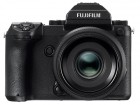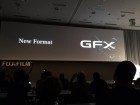
A closer look at Fujifilm's medium format GFX concepts At Dubai's recent Gulf Photo Plus event, Fujifilm gave us a good look at a couple of its forthcoming products, and also allowed us a peek back in time, into the design of existing GFX cameras.
What you're about to see is a collection of mockups of concept GFX designs, dating from before the launch of the GFX 50S and 50R. Some of these mockups appear very familiar, some less so. Click through to take a closer look.
A closer look at Fujifilm's medium format GFX concepts
First up is the camera that got most of the X-Summit audience talking - the very earliest concept mockup for what became the original GFX 50S. As you can see, there are a lot of similarities to the camera that eventually shipped in 2017.
A closer look at Fujifilm's medium format GFX concepts
Top-mounted dials, a central pentaprism-style EVF, lots of controls, a nice big sticky-outy grip. . .
A closer look at Fujifilm's medium format GFX concepts
But in fact, the camera is fully modular. The EVF and grip are optional accessories to the core body of the camera, which consists of the mount, sensor and controls for the key exposure parameters.
Fujifilm's representatives confirmed that the 'Omega' concept was directly inspired by Hasselblad's iconic 500-series square format film cameras. Note the distinctive annular shutter speed dial, positioned around the lens mount itself.
A closer look at Fujifilm's medium format GFX concepts
As originally envisaged, the Omega had a direct control for aspect ratio, and unusual 'roller' style controls, rather than the final GFX's more conventional dials.
A closer look at Fujifilm's medium format GFX concepts
Here are the three main modules - a grip component, the main body of the camera, and a removable EVF. The spirit of the Omega lives on in the design of the GFX 50S's viewfinder, which can be removed to make a slightly smaller, lighter camera.
The main reason why this even more modular design never saw it to production is simple - the shutter mechanism for such a large sensor was simply too large for the concept. That doesn't mean we'll never see a modular GFX, but we might have to wait for global shutters to become a practical reality first.
A closer look at Fujifilm's medium format GFX concepts
Next up is 'Gamma', a design which takes a lot of cues from contemporary XT-series APS-C format cameras.
A closer look at Fujifilm's medium format GFX concepts
Essentially a scaled-up XT, the Gamma would have offered a larger sensor, in a body very familiar to Fujifilm's existing APS-C shooters.
A closer look at Fujifilm's medium format GFX concepts
It's unclear why this design didn't make it beyond the concept stage, but it's possible that Fujifilm wanted to draw a cleaner line between the APS-C lineup and the (inevitably) more expensive GFX range. Also, notice that there's no room for a top-plate display screen in this design.
A closer look at Fujifilm's medium format GFX concepts
A second, unnamed XT-style concept removes the exposure compensation dial and combines shutter speed and ISO into a single (arguably still unnecessary) dial, reducing the amount of bulk on the right hand side of the body. Again, there's no top-plate mounted status screen either.
A closer look at Fujifilm's medium format GFX concepts
Of the two XT-style concepts, this is my personal favorite. The narrower body and simple control layout, with such a large grip is lovely to handle.
A closer look at Fujifilm's medium format GFX concepts
Finally, a glimpse at what the eventual GFX 50R could have been. This is an early concept mockup for a rangefinder-style GFX, but minus the viewfinder. As such, the 'SP-X' actually resembles a cross between the X-Pro 2 and the X70 and XF10 compacts.
A closer look at Fujifilm's medium format GFX concepts
From the rear, the angular SP-X looks fairly familiar - sub-dial ISO control notwithstanding - but with this concept, Fujifilm's design team wanted to experiment with a rear screen that truly blended in to the back of the camera. You can't really tell in this shot, but. . .
A closer look at Fujifilm's medium format GFX concepts
. . . the screen is designed so that when the camera is held in a shooting position, it reversed against the camera.
A closer look at Fujifilm's medium format GFX concepts
To use the screen, it must be folded out, which suits waist-level shooting and image review (but in this position, not much more than that). It's not clear whether Fujifilm envisaged a more complex reversing hinge for the final design, but either way - this is definitely the most conceptual of the concepts. Still though, put put an EVF in there and I might be interested.
What do you think? As always, let us know in the comments.
. dpreview.com2019-2-19 17:00








